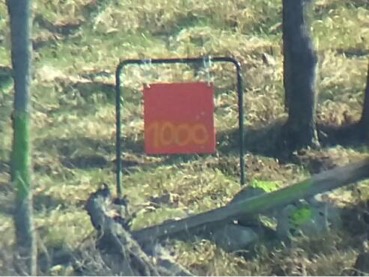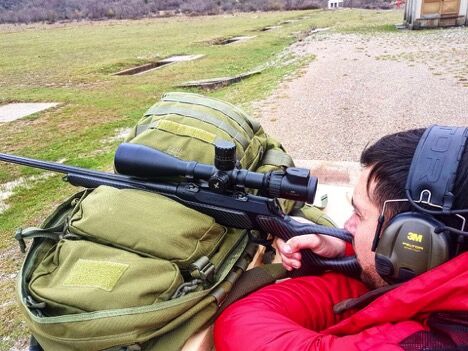
You generally do not have to visit a shooting range at all in order to hear the word MOA. Marketing’s campaigns have pasted that term to almost everything related to the firearms world such as the best rifle scopes, red dot sights, and the accuracy of a particular gun. In the most basic sense, MOA is an expression of accuracy and became the common unit-of-measurement for windage and elevation on most weapons and aiming opto-electronic devices on the North American arms bazaar.
If you are in doubt how to understand Minute of Angle (MOA) and its application in Long Range Shooting Technique, the first step is an official definition.
MOA stands for Minute Of Angle and represents an angular measurement, and it is just a fancy word for 1/60th of a degree. If we want to translate this geometric measure into a more understandable term, like inches, then in the simplest words we say that MOA is nothing but 1 inch per 100 yards.However, if we strictly apply mathematical formulas, the MOA value at 100 yards is 1.047-inch but being so small difference, we simply round it down to one inch for practical use.
For the entry-level shooter who just purchased the rifle with an advertised accuracy of 1 MOA at 100 yards, it means that this rifle should place every shot into a circle of about an inch, measured from center to center of the points of impact. As you assumed since minute of angle is an angular measurement, it is changing at different distances. So in that context, at 200 yards, you should expect to shoot a 3 shot group with in a 2″ diameter circle or 3″ at 300 yards. In bottom table you can find values of shooting groups for 1, 2 and 3 Minute of Angle.
| 100 yds. | 200 yds. | 300 yds. | 400 yds. | 500 yds. | 600 yds. | 700 yds. | 800 yds. | |
| 1 MOA | 1” | 2” | 3” | 4” | 5” | 6” | 7” | 8” |
| 2 MOA | 2” | 4” | 6” | 8” | 10” | 12” | 14” | 16” |
| 3 MOA | 3” | 6” | 9” | 12” | 15” | 18” | 21” | 24” |
The combination of fine rifle, the best rifle scopes and shooter capable of consistent hitting of one minute of angle (MOA) at 100 yards, theoretically guarantee it should place the rounds at longer ranges within 1 MOA. Since the one MOA has a different size at different ranges, it means that 8 inches group at 800 yards is still just 1 MOA.
In order to understand Minute of Angle (MOA) and its relation to long range shooting technique we would describe it as a value that will increase linearly with increased distance. If you have two MOA at 100 yards, it means you are shooting an 2” group, but you will also have two MOA accuracy if you are placing every shot within a 4” circle at 200 or 8” at 400 yards and so on.
When you understand what MOA is, you can easily apply it to practical use, especially in long range shooting application if you use long range scopes equipped with MOA compatible reticles.

While the average hunter would be extremely pleased with 2 MOA groups, more serious shooters will look for Sub-MOA potential. The Sub-MOA rifle offers a single group of shots measuring less than one Minute Of Angle between the two furthest shots in the group. To put it simply, the capability of the gun to consistently deliver a grouping of shots at Sub MOA accuracy is imperative if you are looking to shoot long-range targets.
However,mastering of long range shooting technique includes many different factors and forces that will affect your bullet’s flight. For example changes in barometric pressure as well as thinner air at higher altitudes may affect accuracy. The rule-of-thumb is that for every 5,000 feet of elevation change you should add or subtract one MOA. Another story is with ammunition manufacturer’s rifle ballistic tables that show velocities achieved in testing their loads from the standard 24-inch barrel.
If you are using an inch longer or shorter barrel than manufacturer`s 24 inches, the velocity of your projectile will vary from 10 fps to 30 fps. Indeed, these velocity differences are not critical at 100 yards, but at long range, there is a noticeable oscillation in trajectory.
All of that means you should consider and calculate the influence of the ballistics of your rifle and bullet, and the environmental conditions,including even the Earth curvature, so you will be forced to do mathematical gymnastics all day long. Fortunately, we know that the greatest effect on bullet travel has gravity, which is constant and therefore easier to compensate for. To compensate gravity, we utilize MOA to the position of the reticle in the scope that causes you to efficiently adjust the angle of your barrel to the target.
In addition, the size of the red dot sight`s reticle is also expressed in MOA. Since the usual size of the red dot is 3 MOA, it is slightly larger than a baseball at 100 yards. It is another reason why the reflex sights are recommended for close quarters combat
Conclusion
Like a lot of riflemen, we will also agree with a widely known sentence of one of the most-quoted gun writers Colonel Townsend Whelen: “Only accurate rifles are interesting.” While the accuracy is undoubtedly a most crucial feature of the shoulder-fired gun, it has taken on an almost mythical status thanks to the modern media. Accuracy is important in a hunting rifle to ethically kill an animal with a single shot, but every responsible hunter knows that medium size big game animals have at least an 8″ to 10″ diameter of heart-lung kill area. That means that for the hunter using a 100-150 yard hunting carbine a 4 MOA group will be enough for 100% kills.
Most Sporter rifles are lucky to hold 2 MOA over that distance, so we cannot justify in taking shots longer than 400 yards. In fact, matching the best rifle scopes with rifles that averages 2 MOA groups represents the practical limit of accuracy for most hunters, and the more crucial factor than accuracy is the construction and terminal performance of the bullet.
